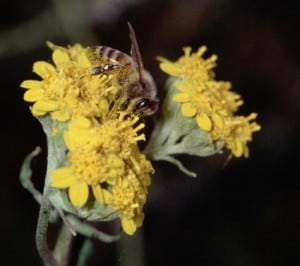Share this article
Native bees struggle to compete in drought-stricken California
Introduced honey bees (Apis mellifera) may be hogging the flowers on California’s central coast, outcompeting native pollinators. When researchers surveyed bees in undisturbed meadows over 13 years, they saw alarming declines in native bumble bees (Bombus spp). The cause appears to be a complex interaction between drought conditions, plant species and rising honey bee populations.
“At my site, honey bees are thriving, and the native bees are actually disappearing,” said Diane Thomson, an ecologist and conservation biologist at the Claremont colleges in California and author of a recent study in Ecology Letters. “I would hope that studies like this one can help draw attention to the importance of other kinds of bees, and not just honey bees.”
Most public concern over pollinators has focused on the honey bees that humans cultivate to pollinate crops. Researchers have also focused on areas where bees are exposed to specific threats, such as pesticides and land use change, says Thomson. But the domestic honey bees introduced by humans have spawned wild populations across the U.S., potentially competing with native bees in both developed and undisturbed areas.
To see how pollinator communities were responding in areas not directly impacted by humans, Thomson surveyed wild bee populations in the Landels-Hill Big Creek Reserve in the Ventana Wilderness. She walked transects through the coastal scrubland in May and June, recording how many of each bee species she observed and which plant species they were visiting.

©Feynner Arias
When Thomson started counting bees in 1999 and 2000, honey bee populations were low, likely due to an epidemic of parasitic mites that swept through nearby domestic hives in the 1990s. She resumed yearly surveys in 2003, and saw a general rise in honey bee populations until the study’s conclusion in 2014. This overall population growth was interrupted by a dip from 2006 to 2011, possibly due to the colony collapse disorder that struck many domestic hives around the same time.
Thomson also frequently observed two species of bumble bees, which look too similar to distinguish in the field. Bumble bees declined over the study period, and they seemed to do worse just as honey bees were doing well.
To find out why, Thomson examined which plants the bees were feeding on. Bumble bees have longer tongues than honey bees, ideal for drinking nectar from plants such as California hedge nettle (Stachys bullata). Honey bees have shorter tongues, and they prefer shallow flowers like the seaside woolly sunflower (Eriophyllum staechadifolium). In earlier research in the same area, Thomson found that bumble bees use their preferred plants when conditions are good, but switch to the sunflower when their favorite plants are scarce, using the sunflower as a backup food source.
While Thomson was collecting data for the new study, drought struck the region, causing the bumble bees’ favorite plants to produce fewer flowers. Under normal circumstances, this wouldn’t have been a disaster, because the bumble bees could switch to the drought-resistant sunflowers. But as hedge nettles and other bumble bee plants declined, honey bee numbers soared.
“Suddenly honey bees have exploded again, and so there has been tons of competition for use of that sunflower,” said Thomson. “What used to be a reliable backup plan for the bumble bees is now no longer available to them.”
Thomson compares the situation to that of a town with two restaurants. If your favorite restaurant closes, you might head to the other one instead — only to find it so crowded that you can’t get in the door.
The research demonstrates the value of long-term studies conducted on the ground, says Thomson. In the past, most studies of native bees have relied on museum specimens to estimate historical populations. But while such data have been crucial for many discoveries, they never identified the species in Thomson’s study as being in peril.
“These species really shouldn’t be ones on our list to worry about,” said Thomson. “It may be that we’re really missing some of the important local patterns by only looking at museum collections, and not actually going out and observing the pollinators in the field.”
Header Image: A bumble bee feeds on a seaside woolly sunflower in the Landels-Hill Big Creek Reserve in California. Bumble bees rely on this plant during drought conditions, but lately they have been excluded from its flowers by non-native honey bees. ©Diane Thomson








